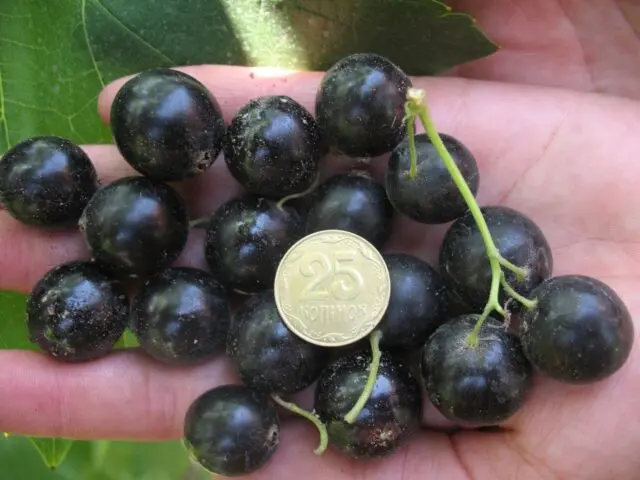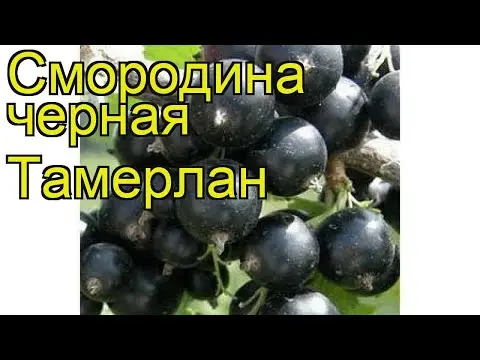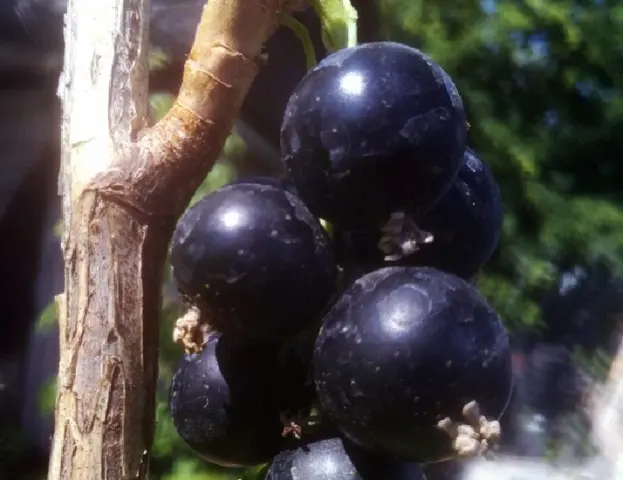Contents
Currant Tamerlan is a variety obtained relatively recently. Valued for large, sweet berries and good yield. The fruits tolerate transportation well, have an attractive presentation. Therefore, you can breed a variety both for yourself and for sale.
History of breeding
Tamerlan is a blackcurrant variety bred by breeders Zvyagina T.S. and Zhidekhina T.V. at the Federal Scientific Center named after Michurin. The varieties Black Pearl and the Ojebyn variety were taken as the basis. The application for admission was submitted in 2001.
After passing the test, the variety was included in the register of breeding achievements of Our Country in 2004. It was approved for cultivation in the Central Black Earth region (Kursk, Tambov, Oryol, Lipetsk, Voronezh and Belgorod regions).
Description of the blackcurrant variety Tamerlane
In the description of the Tamerlan variety, special attention is paid to the size of the bush, as well as the color and shape of the fruit. The main parameters are shown below.
Bush
Currant bush Tamerlane is quite high, the crown is moderately sprawling. Shoots with a layer of lignification, medium size, rather thin. The color is grayish, sometimes with a yellowish tint, there is no pubescence. The apical shoots are yellowish-brown. The buds are medium in size, have an elongated ovoid shape, their stems are short, deviate slightly to the side of the shoots. The leaf scar has a typical round-wedge shape.
Currant leaves Tamerlane of the classical type, with five lobes. They are large, leathery, with a wrinkled, matte surface, the color is green. The plates are located down the slope, bent along the midrib, the edges of the leaves are bent down. Their blades are pointed, and the middle ones are larger than the lateral ones, sometimes they have additional protrusions.
On the sides, the lobes of Tamerlan currant leaves are widely spaced, the angles between the middle veins are obtuse. The basal lobe is well developed. The base of the leaf plate is heart-shaped, the notch is medium. The teeth are small, blunt, bent upwards, serrate in shape, a white “tip” is clearly visible. Petioles are small, thick, green in color.
Blackcurrant Tamerlane flowers are medium in size, shaped like a glass. Sepals of a reddish hue, free, arched back. The brushes are small, up to 7 cm long, cylindrical in shape, straight. The axes are thick, without petioles.
Berries
The fruits of currant Tamerlane are quite large, by weight they reach from 1,4 to 1,6 g, non-one-dimensional, black in color, rounded. Seeds are ovoid, contained in small quantities. The cups are rounded, medium, closed, the stalks are both long and medium in size.

The variety produces tasty berries of an attractive appearance.
Characteristic of the variety
Among the characteristics of currant Tamerlane, the taste of berries, the yield index, frost resistance and other parameters described in the following sections are of particular interest.
Palatability
Tamerlan currant berries taste very pleasant, sweet, with delicate sourness. At the tasting, they received a high score of 4,6 points out of 5,0. The pulp is juicy, with a pleasant aroma, the mass fraction of dry matter is 17,2%. The composition contains:
- sugar – a total of 9,8%;
- acids 3,4%;
- vitamin C – more than 145 mg per 100 g;
- substances with P-activity – more than 950 mg per 100 g;
- pectins – mass fraction 2,1%.
Terms of maturation
In terms of ripening, Tamerlane blackcurrant belongs to mid-season varieties. The fruits appear in July, ripen by the first decade of August. After harvesting, they are consumed fresh, and are also used to make jams and other preparations.
Productivity
The yield of the Tamerlan variety is quite high and amounts to 3,93 kg from one adult bush. With industrial cultivation, you can get 12,9 tons per 1 hectare. To achieve maximum yield, it is recommended to regularly water the bushes, fertilize, loosen the soil and weed.
Frost resistance
Winter hardiness is quite high – Tamerlane currants can be grown without shelter in the regions of the Black Earth region. Cultivation is also allowed in the middle lane, as well as in the Volga region. In these areas, you will need to mulch the trunk circle, tie up the branches and wrap them with agrofibre, and sprinkle them with snow on top. In the Urals and other regions with frosty winters, cultivation can be difficult.
Resistance to diseases
The blackcurrant variety Tamerlan is resistant to diseases such as powdery mildew and leaf spot. But it can suffer from other fungal, bacterial and viral infections. Not resistant to bud mites. Therefore, the bushes need to be periodically inspected and treated with fungicides, insecticides or folk remedies.
Advantages and disadvantages
The blackcurrant variety Tamerlane is characterized by high yield, early maturity. The berries are quite large and tasty. Bushes can be grown both for themselves and for harvest.

The fruits are large, have a pleasant sweet taste.
Pros:
- high yield;
- marketable condition;
- immunity to diseases;
- good transportability;
- winter hardiness;
- high content of vitamin C in berries;
- precociousness.
Cons:
- no resistance to kidney mites;
- the bush is quite large, takes up a lot of space.
How to plant
Planting Tamerlane currants is usually planned for autumn – optimally from late September to mid-October. Seedlings are purchased from nurseries and other trusted suppliers. They must have a healthy root system, without mechanical damage and signs of disease. The landing site should be sunny, without shade, be on a slight hill to prevent the accumulation of water.
A few months before planting the Tamerlane blackcurrant, they dig up the soil on a shovel bayonet and add compost or humus in a bucket per square meter. If the soil contains a lot of clay, sand or sawdust is embedded in it in an amount of 3-5 kg for the same area.
When landing, they act like this:
- Several holes 60 * 60 cm are planned at a distance of at least 1,8 m.
- Fall asleep a layer of small stones.
- The seedling is placed at an angle of 45 degrees.
- Sprinkle with fertile soil.
- Tamp down so that the root neck goes to a depth of 8-10 cm.
- All branches are cut so that 2-3 buds remain on each.
- Watered with settled water.
- After a few days, mulch is laid for the winter – it can be straw, needles, sawdust, dry foliage. The layer should be 10 cm high.
Care instructions
To grow healthy currant bushes of the Tamerlan variety, as in the photo and in the description of the variety, it is recommended to follow the basic rules of care:
- Watering young seedlings weekly, adults – 2-3 times a month. In the heat, too, every week.
- In the spring, nitrogen compounds are added, for example, urea or nitrate. During the appearance of buds, superphosphate and potassium salt are given. Mineral dressings alternate with organic matter, for example, with mullein infusion 1:10.
- The surface layer of the soil is periodically loosened, if necessary, weeding is done.
- In early spring, before the start of sap flow, the bushes are pruned. At the same time, fungicides are treated to prevent fungal infections.

Regular application of top dressing will ensure a good harvest
Conclusion
Currant Tamerlane is an unpretentious winter-hardy variety that produces large berries for universal use. They are well suited for fresh and frozen consumption, as well as for making jams. The rules for growing are quite simple, so even inexperienced gardeners can try to grow bushes.









